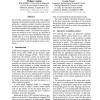Free Online Productivity Tools
i2Speak
i2Symbol
i2OCR
iTex2Img
iWeb2Print
iWeb2Shot
i2Type
iPdf2Split
iPdf2Merge
i2Bopomofo
i2Arabic
i2Style
i2Image
i2PDF
iLatex2Rtf
Sci2ools
76
Voted
EMNLP
2004
2004
Adaptive Language and Translation Models for Interactive Machine Translation
We describe experiments carried out with adaptive language and translation models in the context of an interactive computer-assisted translation program. We developed cache-based language models which were then extended to the bilingual case for a cachebased translation model. We present the improvements we obtained in two contexts: in a theoretical setting, we achieved a drop in perplexity for the new models and, in a more practical situation simulating a user working with the system, we showed that fewer keystrokes would be needed to enter a translation.
Cache-based Language Models | EMNLP 2004 | EMNLP 2007 | Interactive Computer-assisted Translation | Translation Model |
Related Content
| Added | 30 Oct 2010 |
| Updated | 30 Oct 2010 |
| Type | Conference |
| Year | 2004 |
| Where | EMNLP |
| Authors | Laurent Nepveu, Guy Lapalme, Philippe Langlais, George F. Foster |
Comments (0)

